Discover the benefits of Zoysia grass and join the growing trend that has captivated your neighbors and transformed countless lawns. Don't be left behind—explore the world of Zoysia grass and see if it's the perfect fit for your own yard. In this detailed article, we'll delve into the qualities of Zoysia grass. Get ready to absorb a wealth of knowledge as we guide you through every facet of Zoysia grass. By the end, you'll have the opportunity to work with us and install Zoysia grass, should you decide it's the right choice for you. Get ready to revolutionize your lawn with this in-depth look at all things Zoysia.
So first, let's talk about different types of Zoysia grasses. why do they look different, and how to identify lawns in your neighborhood that have Zoysia grass? Go find a lawn near you, and get to know your Zoysia grasses.
Different types of Zoysia grass
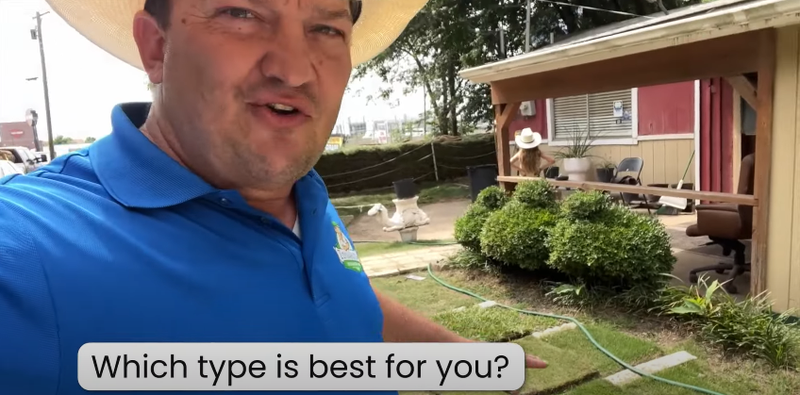
We're going to talk about the pros and cons, and if it's a Zoysia grass, which type of Zoysia grass is best for your lawn. We're going to cover St. Augustine grass, Trinity Zoysia, Zeon Zoysia, and Palisades Zoysia grass. And there's some other grasses, of course, Bermuda grass, Tif-419 Bermuda, common Bermuda, Celebration Bermuda, and Palmetto St. Augustine. There are lots of Saint Augustine grasses like Palmetto, Del Mar, and Raleigh, among others. But today we're going to talk about Palmetto and other warm-season grasses for North Texas.
North Texas Warm-Season Grasses
1: Common Bermuda
Builders typically put in Common Bermuda grass, because it is great for full sun and most new homes do not have large amounts of shade. It'll have those crows feet, seed heads that pop out. It is very drought tolerant and repairs very quickly to foot traffic. Common Bermuda grows a little bit faster than say a Tif-419 Bermuda lawn.
2: Tif-419 Bermuda
Tif-419 Bermuda is going to be usually a step above a builder's grade Common Bermuda. Tif-419 Bermuda is an upgraded Bermuda grass. It looks a little tighter, a little shorter, and doesn't pop up those seed heads as fast as a common Bermuda would. But it's definitely still a full-sun type of grass, needing six to eight hours of sun at least.
3: Celebration Bermuda grass
We’ve got Celebration Bermuda grass, which has a little bit of a bluish tint to it. It'll grow a little bit deeper into the shade. Instead of six to eight hours of sunlight, it probably just needs five to six.
Once you're away from the five to six hours, then we're starting to talk about shade-tolerant grasses or premium turf grasses. And so that's where we're going to start with our St. Augustine and our Zoysia grass. These grasses can also grow in full sun.
4: Palmetto St. Augustine.
Palmetto St. Augustine has long runners. So some people don't like runners, and some people don't care, It looks fine to me. It's what you would consider a wide blade of grass, It needs about three hours of sunlight. And this is what you typically find in a lawn with a lot of shade, which is going to be a St. Augustine lawn. Some people love it. Some people hate it. There are a lot of personal preferences out there. Of course, I'm the Zoysia guy, so I don't particularly like St. Augustine grasses.
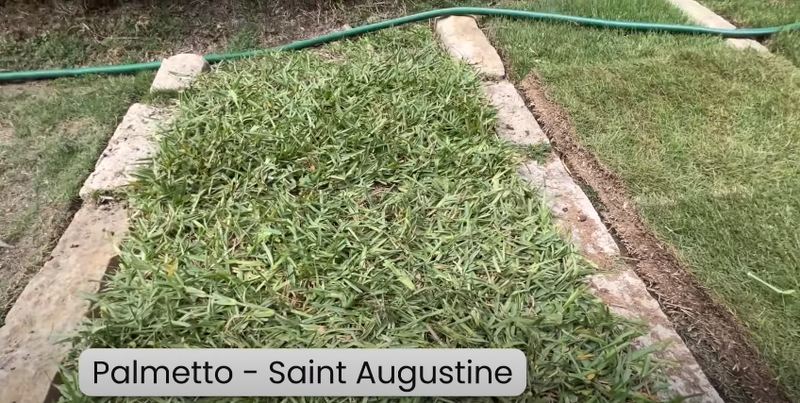
It does have its use though, a lot of people like it. It's an option for you shade-loving people. It also can do full sun. All these grasses can do full sun. But the big pro about these grasses is that they can also go where Bermuda cannot go – and that's like three to four hours of sunlight. So this is the Palmetto St. Augustine.
Now a con is pests will hit all grasses, but fungus just really loves to hang out with the St. Augustine grass. So especially this year in the early spring when every other grass is coming out of dormancy – and Zoysia's not immune to it either – fungus has been knocking out just tons of lawns out there with that brown patch or take-all root rot, chinch bugs, grub worms, lots of stuff will take out a St. Augustine yard.
5: Trinity Zoysia Grass.
It's not like Zeon Zoysia. Trinity Zoysia is not considered an ultra dwarf or anything, but it does grow tighter and shorter and slower than say a Zeon Zoysia grass. It looks just like Zeon Zoysia grass if you let it grow to about 1-1 1/2 inches or something like that. I really don't have anything negative to say about it.
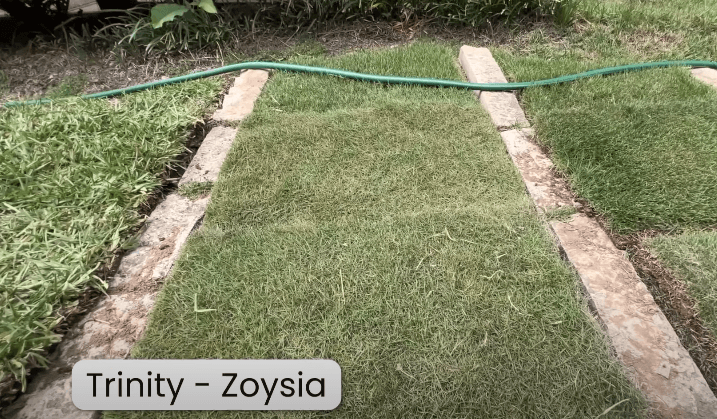
I have seen some winter damage in some of the Trinity Zoysia in my first year of installing this grass, but it’s still come on strong this year in those lawns that have it. So it is shade-tolerant. I think they say it's three to four hours. I'd say the biggest characteristic difference is it's just a short-growing Zoysia grass and it's nearing that dwarf kind of blade. It is a short-growing grass. If you like to reel mow, then this might be the grass for you.
6: Zeon Zoysia Grass.
America's number one Zoysia seller. Surely it's our number one seller of Zoysia grass. It's got a fine blade and nice deep color, and a lot of blades per square inch to help you choke out the weeds. It likes to be mowed at about one inch to one and a half inches. You don't want it to be really tall because you'll start to develop a thatch layer, and then when your mower goes over it's going to be riding on thatch. Before long, you're going to be up at four inches.
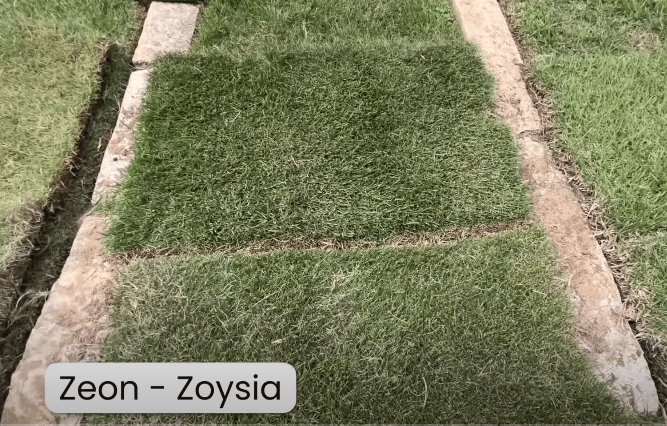
So I'd say start it at 1-1 1/2 inches and leave it there all season because if you start mowing it at two and a half to three inches, it'll develop that thatch layer and then before long it's going to be really thick with thatch. When it thickens up you're going to say, "Oh, I hate Zoysia grass. It's hard to mow," And really it's just being mowed wrong.
So if you find yourself in that situation, I would mow it really nice and tight, bag it up, go get a de-thatcher, de-thatch the lawn, bag up all that thatch, and now you're resetting the height of your lawn. It's going to look like crap for about four weeks, but get it down to your one-inch mark and ride it that way all season long. All right, so that's Zeon Zoysia. Just needs about three to four hours of sunlight. Nice dark green color.
7: Emerald Zoysia Grass.
You can tell whenever you have a dark green versus an emerald green, fine-bladed Zoysia grass. Emerald is just like a Zeon except it needs four hours of sunlight instead of the three to four hours of sunlight. And it's a lighter shade of green.
So I always choose, if clients want fine-bladed grass, Zeon because it needs less sunlight and it's a darker green and that's just a bonus for me.
8: Palisades Zoysia Grass.
Palisades is a medium-bladed grass. Most people think of Palisades, as a beautiful premium yard. It's great, it's soft. Let's run barefoot in this stuff. It grows well in North Texas and is the most shade-tolerant of all the Zoysia grasses needing three hours of sunlight. This stuff is going to be thick and healthy, choking out weeds and doing good.
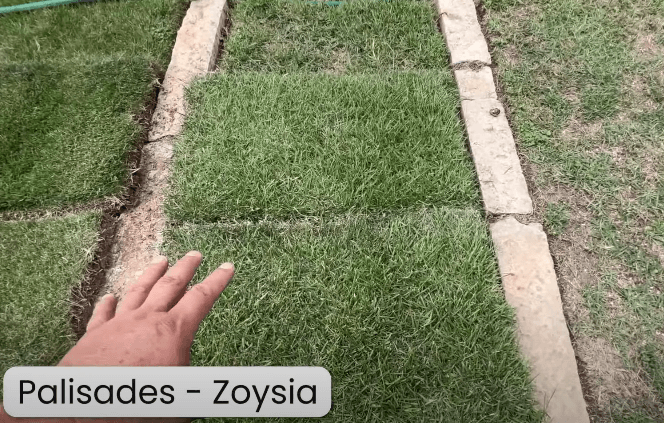
This stuff likes to be mowed at about 1 1/2 – 2 1/2 inches tall. Some people mow their grass taller and that's fine. You're just going to have to de-thatch it and watch out for that fungus. But I like to mow it at 1 1/2 – 2 1/2 inches at the highest. It's going to look amazing and you're going to love it.
Palisade Zoysia, that's our number two seller. And it's only number two because usually when people go to Zoysia grasses, they're coming from St. Augustine and they hate wider-bladed grasses in the first place, and so they're trying to go fine blade. They wish they could have Bermuda, but they have shade or they wanted a Zoysia because they want the best lawn that you can possibly get. But they hate the look of St. Augustine. And so some people think to get the furthest away from St. Augustine, they don't want medium-bladed grass and choose a fine blade, but I think it looks just fantastic anyway.
Zoysia Grass gets shipped daily. It's fresh.
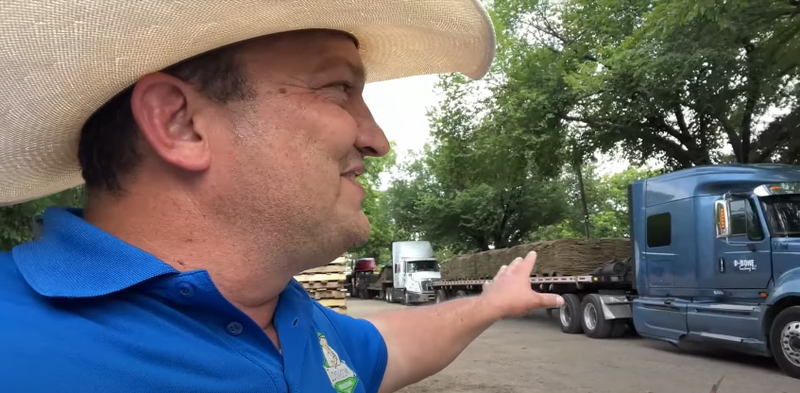
It's about four o'clock today. Trucks are just coming in. They just harvested this morning. It's in Dallas by four o'clock. That's going out tomorrow straight to the houses. Nice, moist sod, ready to go, ready to go down. And that's low-risk grass. That's fresh stuff right there. Well, I like seeing full truckloads of grass coming into town.
So basically to understand which type of lawn you want, when you get an estimate from us, we can just send you a list of local north DFW addresses. You can drive by. They'll say address Palisades, address Trinity, address Zeon. You can go and see them in person. There’s nothing like driving by, seeing it with your own two eyes, not on a phone or on a computer screen, but driving by, seeing them in person.
And of course, if this is a long process for you, you're not ready to pull the trigger, you might want to go see it when it's dormant. You might want to go see it when it's nice and green. Different types of the year. Some of these lawns are going to get the yard of the month even in the wintertime because they always look good.
St. Augustine dominance
You’ve got a nice Zoysia lawn, a fine blade Zeon. Nice dark green color. But there’s the border of this property right at the fence line and St. Augustine has been rushing into your yard.
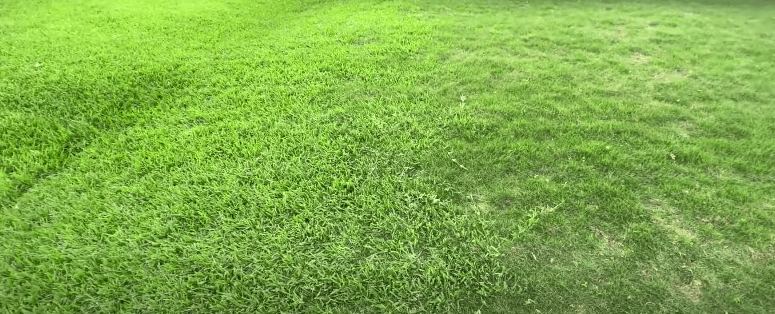
So you're going to want to put up some kind of a border. What I really recommend is just like a four to six-inch stamp concrete border. That way you can see when those runners jump over it, you can whip it with the string trimmer.
Another way to do it is to do those chop-stone borders. So you can do something like that and get your footer in, and have a chop stone border or that stamped concrete border. Anyways, some kind of a barrier. You can't just use metal edging or rubber edging because it'll root in before you even know it.
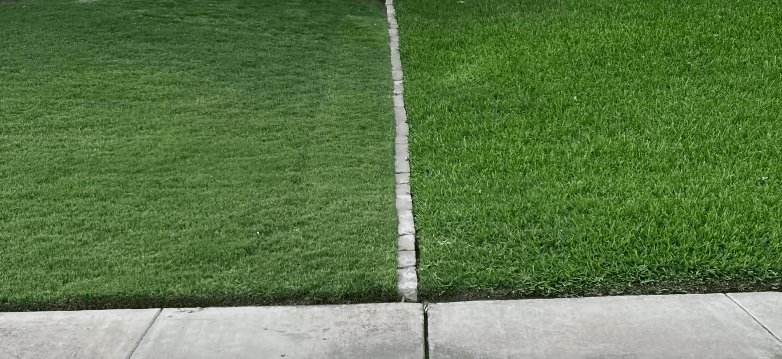
But if you have a four to six-inch wide border, it goes down in the ground about four inches with a footer. Then you have your chop stone, which is about four inches tall. So you're four to six inches of depth. So those roots aren't going to really go under it. And then you have four to six inches wide as well. So the time it takes to crawl over is going to be enough to see that so you can whip it.
Then there's also a chemical you can use!
If you want to treat it with a chemical to eliminate St. Augustine out of your Zoysia and not harm your Zoysia grass, That would be called Quincloric. So look for that in all of the places that you buy chemicals.
Some more about Trinity Zoysia Grass.
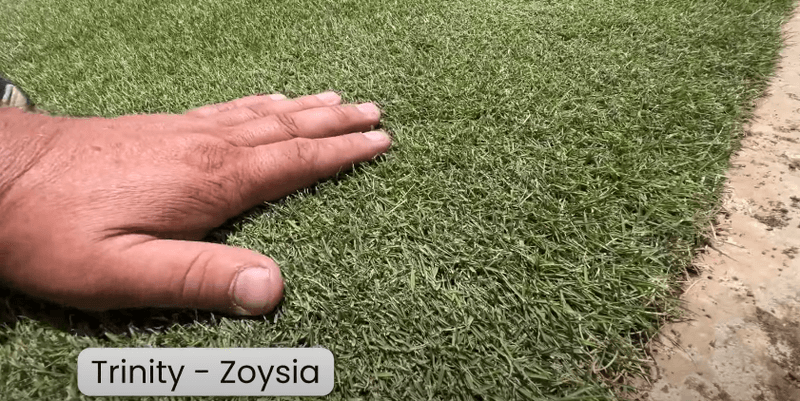
As we talked about, it's going to be cut very short. Trinity Zoysia is that fine-bladed Zoysia. So it kind of looks like a Zeon Zoysia except it's a little bit dwarfer than a Zeon Zoysia. But it looks nice and tight. So if you are a person that thinks maybe reel mowing is for you, give it that kind of golf tee look or something like that, then this is a great lawn for you. It grows really short, really slow. And the color is not as deep dark on it as Zeon Zoysia. But probably some iron or something and you could probably get some more color out of it. But it looks really, really amazing.
More about Palisades.
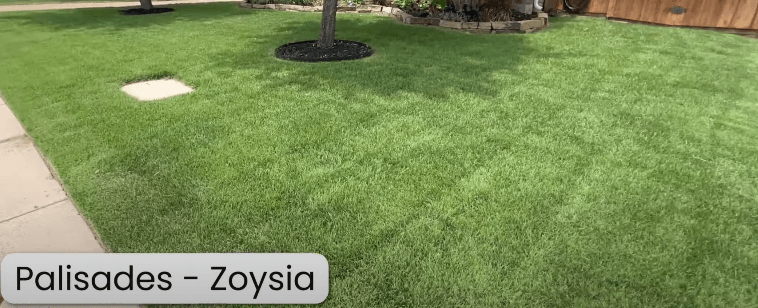
We talk a lot about Zeon Zoysia, but Palisades is a freaking bad to-the-bone lawn. Every homeowner could be proud of that sucker. So Palisades Zoysia, is definitely an option. An option for me. I like Zeon, but I sure am a fan of how Palisades is looking. It's a nice barefoot running lawn. That's nice and soft, Pretty cool. Palisade Zoysia.
Leveling and sprinkler heads
A sprinkler head's supposed to be mounted at the concrete level. A lot of sprinkler heads can end up being too high though. How are you supposed to mow your yard and not scalp the edges? If the mowing guy puts his wheels up there, they're not going to mow the last couple of inches.
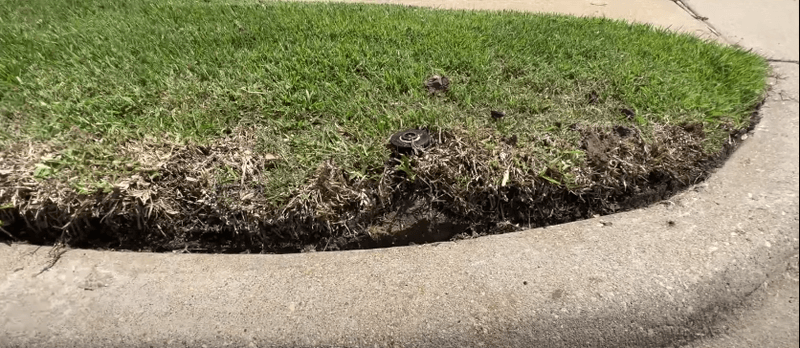
That's why we follow these steps when installing a new lawn
- First, we're going to kill the existing lawn.
- Then we're going to scrape the old lawn off with a sod cutter.
- Next, we're going to run that sod cutter back and forth about five more times inch by inch removing all the excess soil.
- Then we're going to get down to the level of the concrete.
- Then we're scraping two inches lower than the concrete because when we bring our sod out,
- we're going to add some compost mix that we're going to amend the soil with.
- And then we're going to have an additional inch and a half of soil that comes with our sod.
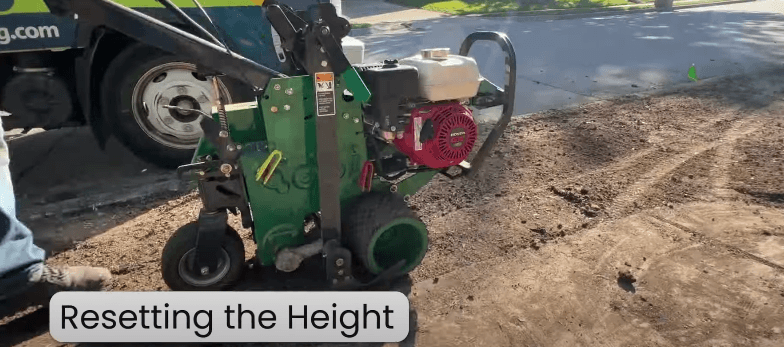
And so then we're going to be flush with the concrete so that when we mow it, we're not scalping these edges. And guess what else we're going to do?
- We're going to drop the height of the sprinkler heads down to a proper level so that your mowing guy doesn't clip them off.
But anyways, when you're out there hiring a sod installer, you want to make sure that they're going to not just slap stuff on top of your existing sod height. They're going to re-level, regrade and re-plane this stuff. And they better bring a couple of dump trucks or dump trailers because they're going to be throwing, on this lawn, will probably throw away about 14,000 pounds of sod.
Sod Installation Process
Stage 1: RoundUp and String Trimming
It's one of my favorite parts where we come through here with some string trimmers and all this stuff is dead. We've killed out all this existing turf. But now we just came through with string trimmers and zipped it down to the soil line. And the guys just blew it all and bagged it up.
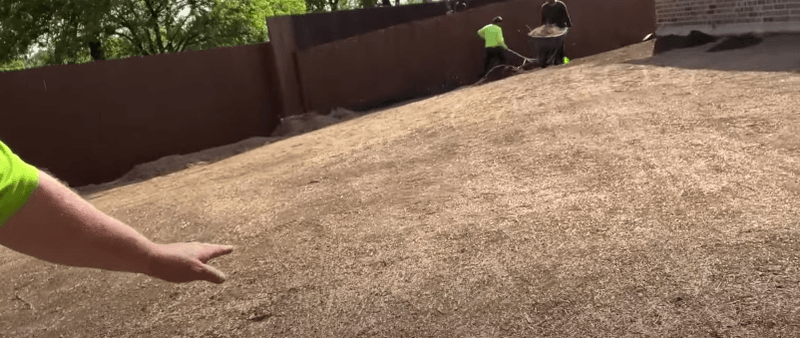
But why it's my favorite part of the sod installation? Is because I can look out across all the soil and see all the uneven spots and stuff. Some people would say they have a pretty level lawn, but it's really hard to tell until you get all that grass off of there because if you mow it a bunch of times, it's all going to kind of look the same. But after you get the grass out of here, then you can see you have some uneven stuff going on with the soil grade. This is part of the process we're getting ready to start our rough grade.
Stage 2: Grading
The guys will knock down the hills with a rototiller, or we can come in with some of this compost-mixed soil which is what we're going to feed the lawn with anyways. This is when we are dragging some of this compost-mixed soil into the low spots. It'll kind of smooth everything out giving us a fine grade, and a good root bed for that new sod. It just looks good. So I love it.
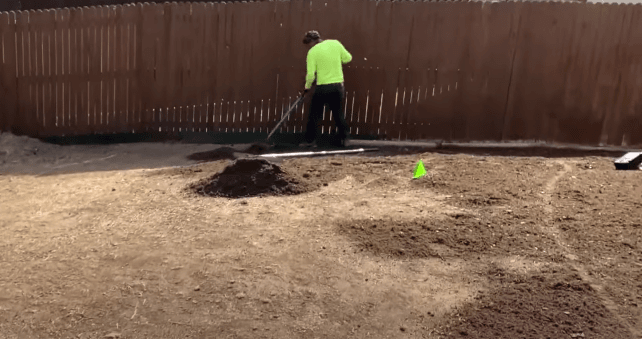
Then we bring our compost soil in – and then this grass turf has some soil that comes with it as well – about an inch and a half of soil there. So we're below the grade of the concrete, but with the new sod, it becomes flush with the top of the concrete and it looks so good. It looks like it's meant to be at that height, nice and professionally done. So that's why we do that.
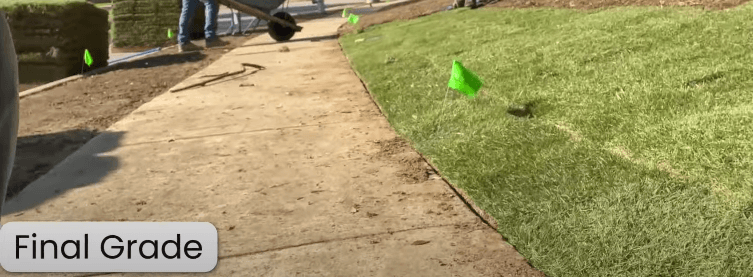
A lot of people don't like that extra work of taking out that soil like we do with the sod cutters. But if you're going to spend a ton of money, I'd say put it in right and make it look really, really good.
Compost mixed soil
Compost-mixed soil is one of those things that helps us to level it out. And you really can't tell what you're dealing with until you get all that grass clippings out of the way.
This compost mix soil is pretty awesome. Compost, it's such a great topic, but it's always warm whenever you get compost. And that's because obviously, it’s decomposing. And it cooks the organic material that you have. And the good thing about that warmth is once it's about 130, 140 degrees inside of that mulch pile, it's going to roast all the weed seeds that are inside of that compost. So it's not going to bring weeds into your yard, because they’re roasted with the temperature of the compost. So that's a pretty cool feature of what compost does.
Stage 3: Turf laying
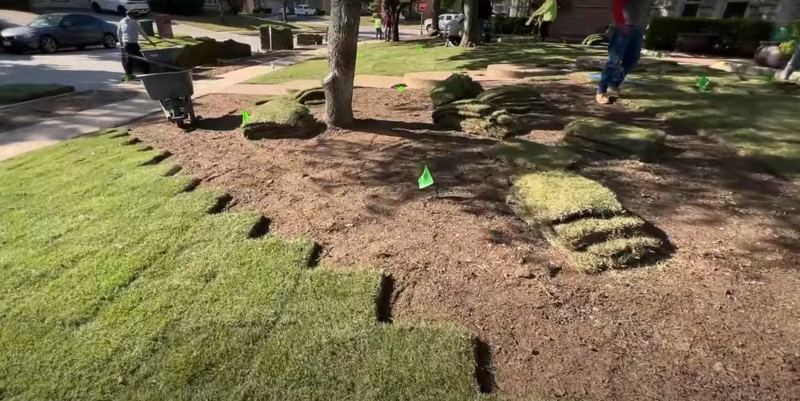
And of course, the next step is that awesome grass. If you guys want to get the best sod install you can, we'll level it up. We'll level these sprinkler heads, and point everything in the right direction.
Next, you might have heard of installing the grass in a brick pattern. Now why do we like to do that on grass, especially if you're kind of on a little bit of a slope? When the water runs off – if the water just went straight down the line – the water would run off faster and you might have a little bit of a cavern from the erosion.
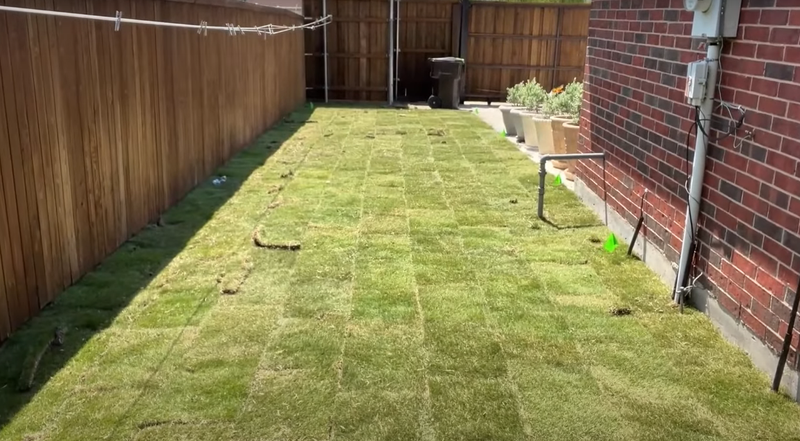
So we can slow the water down by just making it change direction, as it does that, going down the lawn slower. It's going to soak into the soil and you're not going to have as much runoff. You're not going to have any erosion lines down the center. So that's the main purpose of doing a brick pattern.
Sunlight measurement
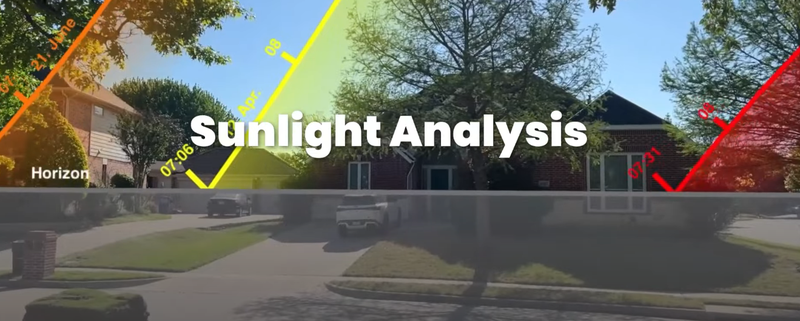
One of the important things we do when we come out and do your sod estimate – it's always important to get somebody out there to look at your lawn – is to see if you have enough sunlight to basically grow a nice lawn. You want to get some sunlight down there. Zoysia likes full sun, but Zoysia also is really healthy to have just a minimum of three hours. So we use this tool. Kind of like a doctor uses an x-ray, the landscaper uses an app to measure your sunlight.
Identifying dry grass
So let's talk about what happens to grass and why it looks different. Whenever a blade of Zoysia grass gets dried out, the leaf kind of curls up. All the moisture is gone. So it shrinks up a little bit and is kind of like what you would do if you were cold. You wouldn't be all laid out, you'd be trying to protect yourself. That's kind of what grass does. Moisture goes out of it. It kind of curls up and tries to go into hibernation mode. So the cool thing is all you got to do is drench that top layer. Just drench it with water, and boom, two hours later it's going to look nice and lush again.
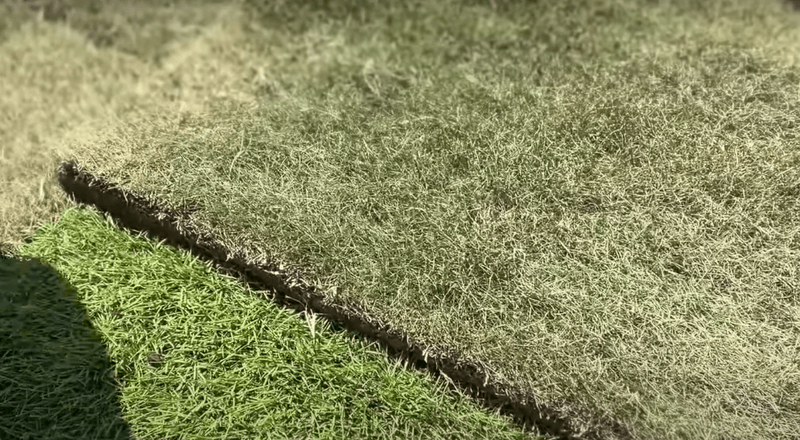
Sprinkler heads

I like a nice pop-up spray with an adjustable nozzle for a lot of reasons. They're pretty versatile in case you got some areas where the lawn isn't perfectly 180 degrees. But you know, you can adjust the pattern by just twisting the top of it. You can really cut it down tight or you can get yourself a nice wide-open pattern. It will do 360 degrees. Of course, I don't want to get all wet right now, so I'm not going to do that. But that's how you can use these adjustable nozzles. And they come in different throw patterns.
So if you want to go six foot or 15 foot or 18 foot, you can buy different nozzles that'll throw further. And if you need more volume or less volume, you just use a little flathead screwdriver right there in the middle. Just hold onto it and turn it and it'll give you more volume or less volume if you got a little tight spot and you don't want to throw a bunch of water. But invest in those things. Those are really easy. It's kind of like an all-purpose kind of nozzle. So have a couple of those in the garage. Whenever we're installing sod, we'll definitely have plenty of those with us. So when we're installing your grass, we're going to make sure we fine-tune your lawn. So that's an adjustable pop-up spray nozzle.
Dog urine
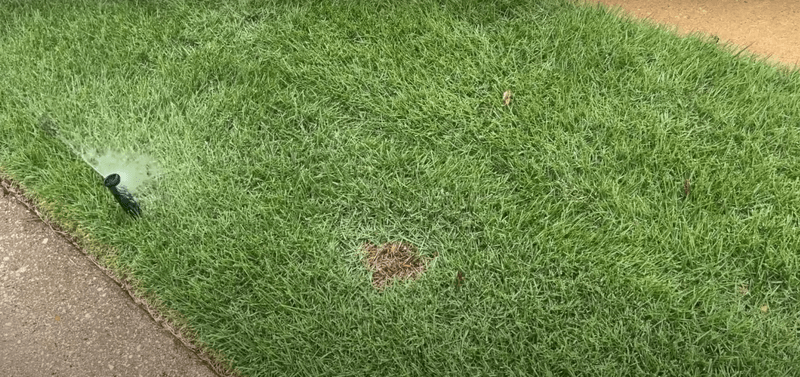
Yes, dogs do pee in our parkways when people take a walk. So keep that in mind when you have two to three big German shepherd dogs or something like that with a lot of urine. This looks like it came out a little chihuahua or something, but you can expect a much larger puddle whenever you have a larger dog. And obviously, if you have just a very small backyard with a bunch of big dogs, you're not going to have much of a lawn.
So 1000-1350 square feet roughly for one dog. If you have a very small lawn, think about that. Three pallets of grass are about good for one full-size dog. And all that means is you're going to have some great grass and some areas with some puddly burn marks. So if it's much smaller than that, you're going to have a whole bunch of burn marks, and at that point, I'm like, "Hey, you might want to think about artificial turf if you have that small of a yard." It's still a big investment for artificial turf, but maybe it'd be better than looking at a whole bunch of burn marks that are huge. So kind of keep that in mind.
There are some methods that people use to minimize those. And you can find YouTube videos about how to concoct a tea or something like that that'll neutralize urine stains in the grass, but that's not my specialty. But I just wanted to bring to your attention kind of what it looks like to identify urine stains from a dog in your yard.
Fungus
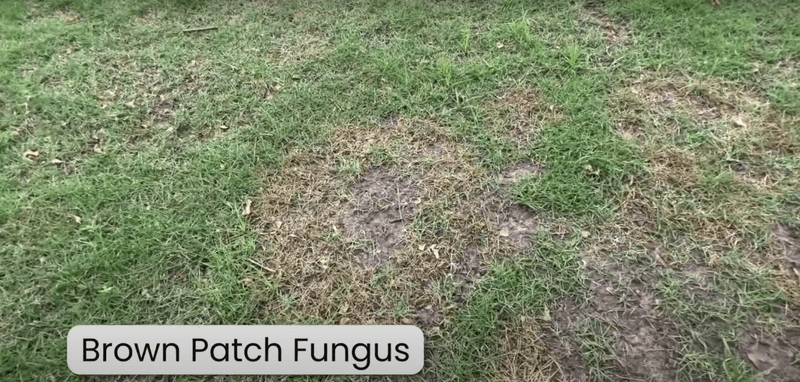
So kind of similar to St. Augustine, you can get a fungus, which is kind of like a circular pattern here with a little copper color in it. So when you see stuff like that, we like to put down a Heritage G fungicide and maybe some sphagnum peat moss to limit the movement of that fungus. So just because it's a Zoysia doesn't mean it's immune to the fungus, but it's not going to get obliterated like your St. Augustine will.
But kind of be on the lookout for any circle patterns. And if you see stuff like that, it's usually going to be in the early spring when the cool temperatures are present. The heat really knocks that stuff out. But when it's slow growing, it's a little bit of moisture in the ground, or if you put down a lot of nitrogen, nitrogen's going to feed that fungus.
Anyways, just a starter fertilizer, low nitrogen is going to not create such a fungus problem for you. But you can get it even in Zoysia grass.
Moles
Another thing that we always hear about is when you have a very poor root structure, to begin with, you have a bad lawn, and you want us to come and replace it. You have an infestation of moles sometimes because without a hard awesome root structure, those moles can basically just run through your yard and eat those grub worms or whatever else they're chasing.
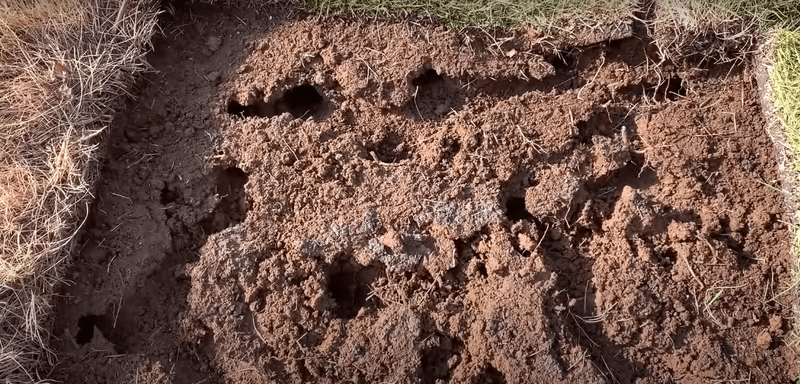
So what we recommend is putting it down, you can get it on Amazon, it's called MoleMax. But you use that MoleMax on your property and all it is is granulated castor oil. Start at one end of your property and you spread, maybe a fifth of your property, and then you go to the next part of your property and the next. And what you're doing is you're pushing those moles off your property.
Don't forget to do your flower beds because you don't want those moles just to go run and hide in your flower beds. Moles are something you definitely want to get rid of before putting down a new lawn because when they do burrow underneath the soil, they create those little caverns underneath and if you're watering your new grass, all that water's going to fall down into the caverns and leave the top layer dry. So you don't want to have that sod all dried out. You want to get rid of those mole holes and let the water stay right there on the surface underneath the sod.
Does Zoysia Grass Need Irrigation?
I often get asked, is it okay to go ahead and install the grass without an irrigation system? I don't have an automatic sprinkler, I'm just going to use a manual sprinkler. We say it's not recommended because you're going to have to water a lot. We are in Texas, there is heat, and we want you to have enough water.
So you're going to water at 4:00 AM or 5:00 AM, 12 minutes per zone if you have pop-up sprays. If you have the rotors, the mechanical moving kind of sprinklers, those are like 22 minutes a zone. And if you're going to use a garden hose in one of those rainbow-type kinds of mechanical sprinklers, that's going to be say 20 minutes per zone. Then you're going to have to pick it up and move it over all the areas. That's going to take a lot of time, and you have to do it twice a day.
So we water it early morning and then it dries out around two o'clock and we need to keep this wet. So then we go through the whole process again at two o'clock. So obviously if you're out there with the garden hose, it's going to take you about two or three hours and then the same in the afternoon.
So definitely install a sprinkler system before you install your sod. If you're going to invest all this money, you don't want to have any risk involved. You have to put a sprinkler system in, it's the first process to install grass when you live in Texas. You have to have that sprinkler system in, operational, and functional, and get all of the turf areas wet so that you can minimize your risk and grow a great lawn.
Mowing Height
If you have fine-bladed Zoysia grass like Zeon, Zorro, Emerald, or Cavalier, it needs to be mowed at one inch to one and a half inches.
If you have a medium-bladed Zoysia grass like Palisades, Crown, or Jamur zoysia then you will want to mow it at one and a half to two and a half inches.
A lot of people like to mow their Zoysia grass even taller. It looks phenomenal at three inches, four inches. But it's going to develop a thatch layer.
What is Thatch and how to avoid it in Zoysia Grass
The sun's not going to get in there and help you to decompose those grass clippings when you mow the lawn tall or over-fertilize. So this thatch (dead grass) layer is going to build up and eventually your lawn mower is going to not be able to go all the way down to the soil. Now it's going to be riding on a layer of slow composting thatch.
Eventually, that thatch layer just builds all the way up and now you've got a really thick Zoysia lawn and you start to say things like, "Ah, Zoysia is just hard to mow," or, "My mower isn't strong enough to mow this Zoysia grass." And that's because you're mowing it too high to begin with.
And that big thatch layer is going to start to build a fungus layer. And you're not going to have a healthy lawn. It's going to look cool in the beginning, but in the end you're going to wish you never installed Zoysia grass.
But the easy thing to do is run a de-thatcher through there, get rid of that thatch layer, and then in the spring you're going to scalp it and bag it. You're going to reset the height of your lawn and maintain it at the proper height. It's going to be healthy, it's going to be easy to mow, it's still going to choke out weeds, it's still going to look beautiful.
Reel mowing
All right, here's another question everybody wants to know. “I heard you always have to buy a reel mower or a putting greens mower for Zoysia, is that true?” and that's not true. You can definitely use your normal 21-inch rotary mower like you would normally see in the neighborhood. You don't even have to bag your grass. Some people choose to, but you shouldn’t have to.
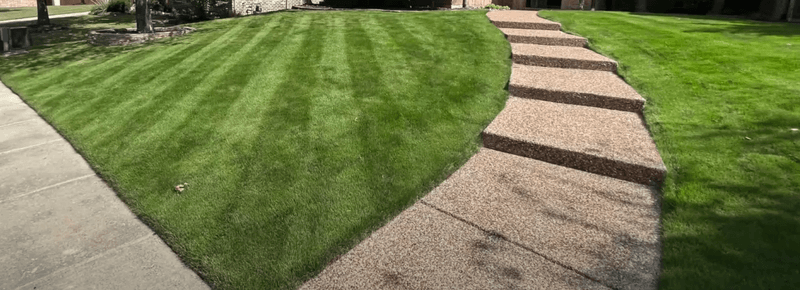
The only time you need to bag your grass is if you mow it and there are a lot of clippings on top of the lawn. And usually, that just means you probably have a little bit too much fertilizer or there might be a few weeks out of the year where it's grown a little faster. In that case, I just hit it with the blower or maybe mow it one more time to chop that up a little bit more. But other than a couple of weeks out of the year, it shouldn’t be an issue.
But a reel mower is a great look. So if you do find yourself wanting to cut your yard at half an inch, well, a rotary mower's only going to get you down to about a 0.75 inch if you're lucky. Reel mowers have seven to eleven blades on a spool instead of one big blade on a 21-inch mower or something you normally see in the typical homeowner's garage there.
So yes, a reel mower, they do have a cool cut. Definitely not required for Zoysia grass. And if you do invest in a reel mower, you're also investing in effort and time, and maintenance because those mowers aren't easy to maintain. But I think the reward is there if you want to research some reel mowing and get that special look for your grass.
Looking for a Zoysia Sod Installation in DFW?
If you're looking for a sod installation in the Dallas Fort Worth area, we work mostly in the North Dallas Fort Worth area above 635. But only if you want to do a lawn renovation, we don't want to come out and do half a pallet of grass or pallets underneath the tree to fix your shade problem. But if you're wanting to change your lawn, the whole front lawn, the whole back lawn, or both and get some Zoysia grass, well, we would love to work with you!
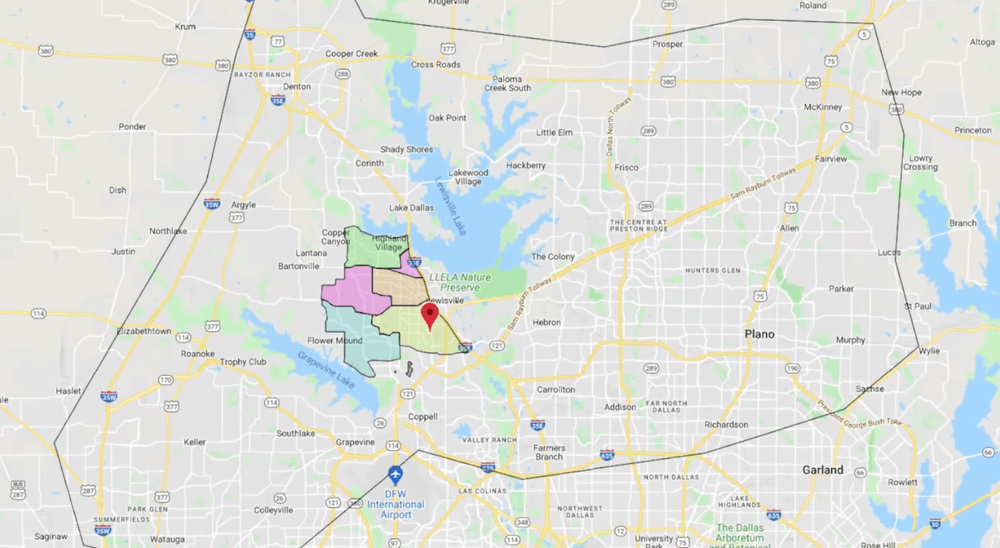
“So that being said, do you want to find out more about how you can work with us? Go over to zoysiasod.com and get started. First, we're going to get you a satellite estimate super quick, which is pretty close to our final price.
Anyways, you're going to get your satellite estimate, you're going to look at that to see if the price is okay, and we're in the ballpark of your budget for the project. Then you're going to click a little link to book a time. You click that, you book the time and we're going to come out, we're going to do a hand measurement, which is more accurate. We're going to see your sunlight availability. We're going to make some recommendations on tree trimming if you need it. And we're going to make sure that your yard is ready to support a new sod installation of Zoysia grass. And then we're going to give you that final price, right there at the appointment. And then you can put the project on our schedule. Anyway, that's how it works.
So if you like that, you want us to handle your renovation, go to zoysiasod.com to get the best lawn on the block this season!” ~ Tanner Maxson

